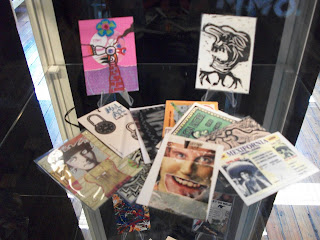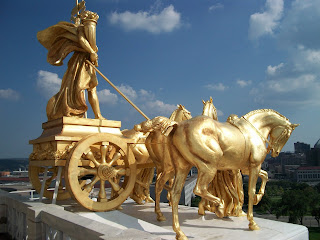
The Soap Factory building began its life as a part of the railway and milling industry, but changed hands as industry declined and has spent most of its time as.....(surprise!) a soap factory. As that business moved on after decades, the space was abandoned for many years and fell into disrepair, before a chance meeting with a member of what was then called “No Name” studios led to the building becoming the alternative gallery space it is today.
No Name studios had thrived in the Warehouse district of Downtown Minneapolis long before it made its way to becoming the Soap Factory. A studio and alternative galley all on its own, it was completely run by artists and volunteers, unencumbered by the rigidity of commercial and conventional spaces, and free to be guided by the art, not vice versa.


Most of the work shown at the Soap Factory is installation and conceptual art, which to me has a very strong impact and can be quite stunning. The Soap Factory has a binder full of artist's statements, so you can be informed as to their concept being represented. There were many fantastic pieces sharing the space.
One of the pieces that I really appreciated wasn't the most obvious, but I felt drawn to it, in part due to the concept and idea from the artist. It is by Alison Owen, and is a wallpaper-type piece that fills one wall, with bits and pieces found in patches on other walls and the floor. It's a lovely design, and what first appears to be a muted gold color is revealed as something else entirely upon close inspection. Hair, lint, slivers of wood, flecks of dust – debris, from the gallery itself, is the material this lovely design is constructed from. It is quite a juxtaposition, which is part of the artist's intent. In her statement, Owen describes her work as parasitic and passive-aggressive, in that it appears to be docile and soft, but takes from the space to add to itself, and slowly installs itself as a force of its own, quietly informing the nature of the space. In a way, Owen's piece involves beauty and ugliness in a symbiotic relationship.
The other work that really struck me was a surprise sleeper hit. It wasn't the most complex or intricately constructed, but it inspired in me such pure wonder and joy that I would be doing a disservice if I do not feature it here.
The work is “Wireframe,” by Scott Rogers. Hidden behind a double blackout curtain behind a mural work (aren't the best things always found that way?), I entered a large room filled with bright light, emanating from boxes pointing in every direction of the room, and I could make out some tape used as trim detail around the room.
I liked the light boxes, and just as I was turning to leave......SNAP! They went out, and I found myself in a different room altogether.
The room was pitch black, but lit by the glow of the photoluminescent tape that ran along the edges of every architectural detail of the room. I was awestruck. I was giddy! It was like existing in a photo negative. Everything was simplified, but any detail that the room had was suddenly more present and important than it had ever been.
I scampered excitedly about the room, taking it all in as much as I could before the lights came on again and it was ripped away from me.

I had the wonder of someone seeing the world inside-out, the excitement of a kid with a friend and a flashlight in a blanket fort, where only the dewy face of the one telling the story is illuminated.

In his statement, Rogers talks about wanting to bring attention to architectural details of a space that might otherwise go unnoticed, and to do this yet stiff affect the space as minimally as possible. He also discusses how this piece has a visual effect similar to very early computer representations of reality, such as TRON. I must say, it really is like being in a virtual room from back when computer screens came only in black and green. Lastly, Rogers touches upon how the change the piece undergoes when the lighting goes off can underscore a change within those viewing the work and their own self perception. I know this is true for me – when I first entered the room, I was content to hang back and look at a distance, separate from the work, but once it changed, I wanted to be in the room, looking at it from every perspective and angle possible, not just close to it but part of it.
Also amazing:
Brett Smith's “Barricade”
Wendy DesChene's “PinkHorn DuckFeet – Generation 9”
Lauren Herzak-Bauman's “Memory Eternal”
Adam Parker-Smith's “Umbrella Cloud”
Eileen Maxson's video work, “Cinderella+++” was beautifully constructed, hilarious, and awesome.
As to the Soap Factory itself, I thought the gallery was perfect and incredible. The character of the structure lends itself well to free flowing, boundless creative expression, and the very rawness of the space allows you to experience the art in a more visceral way, to feel free to be physically and emotionally engaged in the work, to let yourself go past mere observation. It also has some beautiful details of its own.
But then, I do love old buildings.
Go visit the Soap Factory! Or at the very least, go play in the dark!
-Catherine



















































